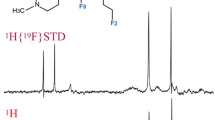Abstract
The long-wavelength fluorescence probe, Nile Red, has polarity-dependent fluorescence intensity and wavelength properties that can be used to monitor the binding of drugs and other ligands to plasma proteins such as albumin and α-1 acid glycoprotein. This paper shows that it can be used in tandem with another fluorescence probe, 1-anilinonaphthalene-8-sulfonic acid, to study two or more types of ligand binding sites simultaneously. Some ligands displace one or the other probe from the protein/dual-probe complex, other ligands displace both probes. In each case the resulting decrease in fluorescence can be used to estimate the numbers of binding sites and their association constants.
Similar content being viewed by others
References
G. Sudlow, D. J. Birkett, and D. N. Wade, (1975)Mol. Pharmacol.,11, 824.
P. Greenspan and S. P. Fowler (1985).J. Lipid Res. 26, 781.
M. B. Brown (1993) Ph.D. dissertation, Loughborough University of Technology, Loughborough, UK.
Author information
Authors and Affiliations
Rights and permissions
About this article
Cite this article
Brown, M.B., Edmonds, T.E., Miller, J.N. et al. Use of Nile Red as a long-wavelength fluorophore in dual-probe studies of ligand-protein interactions. J Fluoresc 3, 129–130 (1993). https://doi.org/10.1007/BF00862729
Received:
Issue Date:
DOI: https://doi.org/10.1007/BF00862729




